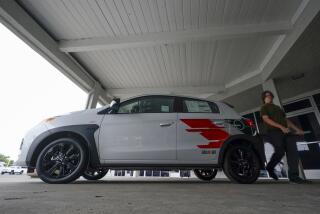Mitsubishi Faces a Rough Road to Bumper Sales
- Share via
Earlier this month, hundreds of employees at Mitsubishi Motors North America gathered with their new boss at company headquarters in Orange County to celebrate Sport Compact Magazine’s “car of the year” award for one of their most eye-popping products, the Evolution.
The magazine’s editors, Chief Executive Finbarr O’Neill declared, “have affirmed that with Mitsubishi, high performance and value are synonymous.”
Now, if he could only get car buyers to see that.
As O’Neill readily acknowledges, Mitsubishi has significant problems, the kudos for the Evolution notwithstanding. (Even the magazine award is unlikely to help flagging sales. The Evolution is a 271-horsepower road rocket aimed at the enthusiast market; it doesn’t have wide appeal.)
Mitsubishi Motors Corp. is the largest of five Asian car companies to lose U.S. market share this year. Through November, its U.S. sales were down 24% to 238,391 cars and sport utility vehicles.
Its full-year sales are unlikely to top 265,000 units. That contrasts sharply with the record 345,111 vehicles the company sold in the United States last year.
Mitsubishi now ranks fifth among Asian automakers in the U.S., behind Japanese rivals Toyota Motor Corp., Honda Motor Co. and Nissan Motor Co., as well as Hyundai Motor Co. of South Korea.
Chief among Mitsubishi’s troubles is the lack of a marketable image after years of showcasing cut-rate deals -- and little else -- in its advertising. Although Mitsubishis rate well in quality surveys, the company has done little to communicate that fact.
“They’re not known for anything anymore except low price, and that’s not enough in this market,” said Jim Hall, Michigan-based vice president for market research firm AutoPacific Inc.
O’Neill -- who joined Mitsubishi in late August from Hyundai’s American unit, where he was credited with resuscitating its once-moribund operations -- is keenly aware of the challenges ahead. The key, he said, is “to give people a reason, other than the deal, to tell their neighbors why they bought a new Mitsubishi. We need to communicate our value story.”
Part of that story is bound up in the company’s ties to DaimlerChrysler. The German-American automaker owns a controlling 37% stake in Mitsubishi and intends to leverage the connection by sharing engineering and product development.
By 2007, as many as five of the 10 new or redesigned Mitsubishis scheduled to hit the market will share components with products in the United States from Michigan-based Chrysler Group. One of the first will be a new Mitsubishi mid-size pickup. The 2005 model will be designed at the company’s studio in Cypress in Orange County but will be built on a platform shared with the redesigned 2004 Dodge Dakota pickup.
Turning Mitsubishi around won’t be easy.
AutoPacific’s studies show that many Mitsubishi buyers have been bitten by sagging resale values and tell researchers they won’t purchase another.
The pool of young buyers Mitsubishi wooed with its hip commercials and loose financing -- interest-free loans with no money down and no payments for the first year -- dried up when every other automaker began offering hefty rebates and incentives last year.
Meanwhile, many marginal customers, who had been propping up sales since the late 1990s, began defaulting. “If you were breathing, you could get a loan,” Torrance Mitsubishi dealer Jim Speck said. In the last 21 months, Mitsubishi has written off almost $800 million in bad loans in North America, and some analysts expect the write-offs to top $1 billion when the company’s current fiscal year ends March 31.
As a result, the once-profitable North American operation, with sales concentrated in the United States, turned into a big money loser. For the six months ended Sept. 30, Mitsubishi Motors in Japan reported a loss of $721 million. It blamed the deficit largely on U.S. performance.
As sales have stalled, Mitsubishi’s dealers have rebelled. Many stopped taking delivery of new stock after the company tried to force vehicles upon them to trim factory and distributor inventories. By midyear, Mitsubishis were going unsold for an average of 100 days, twice as long as normal, adding to dealers’ carrying costs.
With the problems piling up, Mitsubishi North American Chief Executive Pierre Gagnon resigned Aug. 31. A few days later, Mitsubishi named O’Neill to replace him.
One of the first public moves by O’Neill was the layoff early this month of 200 headquarters employees in Cypress, leaving about 800. He also said that as many as 425 jobs at Mitsubishi’s 3,200-employee U.S. manufacturing plant in Normal, Ill., were at risk in the first quarter of 2004.
O’Neill told employees that the headquarters layoffs, mainly affecting credit and marketing employees, were a necessary part of a restructuring that would mean less emphasis on selling vehicles at any cost -- and more of a focus on the product itself.
“While we have built brand awareness ... we have not given people specific reasons to buy a Mitsubishi,” O’Neill said. That will change as the company undertakes a marketing campaign beginning Jan. 19 for the ’04 Galant sedan.
“There will still be an emotional side to the ads, but we will give people more information about the cars ... and by summer the cars will be the stars,” O’Neill said.
He added that he also intended to revamp Mitsubishi’s incentive program to give dealers more flexibility and to eliminate the idea that the only way the company can sell its cars is to discount them.
To that end, O’Neill said, direct consumer rebates and low- or no-interest financing programs will be reduced and the money will be handed out to dealers, who can then beef up posted pricing and use the so-called hidden rebate money in negotiations with individual customers.
That’s the system used by Honda and Toyota, and the result is that buyers still can get a deal while posted prices remain strong, boosting the brand’s image and the resale value of used vehicles. Even if O’Neill revamps Mitsubishi’s message, some wonder whether the company has the goods to compete.
The company’s offerings -- including the Galant, the new Endeavor sport utility, the Eclipse sporty coupe and Montero SUV -- “just haven’t had anything to set them apart from similar products” offered by better-known companies such as Honda and Toyota, said Dan Gorrell of San Diego-based Strategic Vision, an automotive market research firm.
Said Bruce Belzowski, senior researcher at the University of Michigan’s Office for the Study of Automotive Transportation: “They’ve got to get product that excites people, and so far we are not seeing any.”
O’Neill began his automotive career as corporate counsel at Hyundai. He was named president of the Fountain Valley-based importer in 1997, when the troubled company could find no one else to take the job. He oversaw a vast improvement in the quality of the cars that Hyundai shipped to the U.S. And he reversed Hyundai’s fortunes here with an industry-leading 10-year, 100,000-mile warranty on crucial powertrain parts, including engines and transmissions. The warranty convinced shoppers that Hyundais were worth buying, and sales soared.
That background, many believe, makes O’Neill the perfect guy to have behind the wheel at Mitsubishi. “He’s a good choice,” Gorrell said, “because he’s had experience bringing a brand back from the dead.”






